Article
High-frequency UBM helpful tool in strabismus reoperation
Orlando—The high-frequency ultrasound biomicroscope (UBM) can reliably estimate the distance of horizontal muscle insertion from the limbus in eyes that had previous strabismus surgery on the same muscle, according to Shuan H. Dai, MB, BS, FRANZCO, a pediatric ophthalmologist.

With this available information, surgeons can lessen the risk of potential perioperative complications such as excessive surgical manipulation, prolonged procedure time, and unnecessary scarring of the conjunctiva, said Dr. Dai, who presented a poster at the annual meeting of the American Academy of Pediatric Ophthalmology and Strabismus. At the time of the poster presentation, he had been a clinical fellow in pediatric ophthalmology and strabismus, department of ophthalmology and visual sciences, The Hospital for Sick Children, Toronto. He is currently a staff pediatric ophthalmologist at the department of ophthalmology, University of Auckland, New Zealand.
A previous study, published in 2002, had shown that the high-frequency UBM was able to estimate horizontal muscle insertion from the limbus reliably in eyes undergoing primary surgery, and investigators at the Toronto Hospital for Sick Children wanted to assess its capabilities in eyes that had previous surgery on the same muscle. They were also interested in finding a measurement system that would be useful in assessing muscle disturbance in the many patients who are referred without records of previous surgery or other eye diseases, Dr. Dai said.

"We found quite good correlations between the two methods," Dr. Dai explained. The mean distance of horizontal muscle insertion was 9.035 mm with UBM and 9.341 mm with the surgical caliper. The difference between the two methods was within 1 mm in 80.5% of the muscles measured.
Measure of accuracy
It appeared that the UBM was likely to underestimate the distance of the muscle insertion from the limbus, Dr. Dai said. This might have been due to significant scarring around the muscle insertion site from previous surgery, which could have produced irregularities in the insertion site and made it difficult for the UBM to detect a clear muscle echo, Dr. Dai said. Alternatively, the muscle could have been stretched during the UBM measurement, narrowing or abolishing the space between the muscle and sclera and making it less discernible.

To obtain the measurements, the UBM transducer was held tangentially over the muscle and moved with oscillations perpendicular to the limbus, until a cross-section of the muscle was seen on the monitor.
The caliper was then introduced with one arm fixed to the limbus and the other adjusted until the tip of its echo was seen on the UBM image. The echo helped measure the distance from muscle insertion to the limbus because the horizontal resolution of the UBM was less than 5 mm.
Newsletter
Don’t miss out—get Ophthalmology Times updates on the latest clinical advancements and expert interviews, straight to your inbox.





